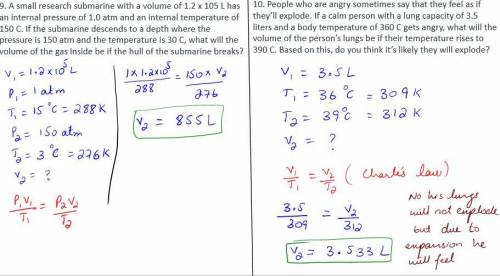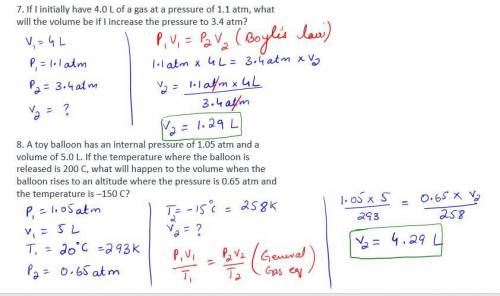
Chemistry, 17.09.2021 01:00 kiylabeasty7302
Please Help
7. If I initially have 4.0 L of a gas at a pressure of 1.1 atm, what will the volume be if I increase the pressure to 3.4 atm?
8. A toy balloon has an internal pressure of 1.05 atm and a volume of 5.0 L. If the temperature where the balloon is released is 200 C, what will happen to the volume when the balloon rises to an altitude where the pressure is 0.65 atm and the temperature is –150 C?
9. A small research submarine with a volume of 1.2 x 105 L has an internal pressure of 1.0 atm and an internal temperature of 150 C. If the submarine descends to a depth where the pressure is 150 atm and the temperature is 30 C, what will the volume of the gas inside be if the hull of the submarine breaks?
10. People who are angry sometimes say that they feel as if they’ll explode. If a calm person with a lung capacity of 3.5 liters and a body temperature of 360 C gets angry, what will the volume of the person’s lungs be if their temperature rises to 390 C. Based on this, do you think it’s likely they will explode?

Answers: 2


Other questions on the subject: Chemistry

Chemistry, 21.06.2019 14:30, mere33
Janel’s class studied properties of matter and how matter can change. janel decided she would do an experiment mixing baking soda and vinegar. question: describe the properties of baking soda and vinegar, and explain the changes that janel should see when she mixes the two types of matter. •first, identify the physical state of matter of baking soda. describe another property of baking soda. •next, identify the physical state of matter of vinegar. describe another property of vinegar. •then, explain what janel should see when she mixes the baking soda and vinegar. •describe the states of matter of the new materials that are formed. •explain how janel can be certain a change has occurred. me
Answers: 3

Chemistry, 22.06.2019 11:40, arlabbe0606
Effect of rotenone and antimycin a on electron transfer rotenone, a toxic natural product from plants, strongly inhibits nadh dehydrogenase of insect and fish mitochondria. antimycin a, a toxic antibiotic, strongly inhibits the oxidation of ubiquinol. (a) explain why rotenone ingestion is lethal to some insect and fish species. (b) explain why antimycin a is a poison. (c) given that rotenone and antimycin a are equally effective in blocking their respective sites in the electron-transfer chain, which would be a more potent poison? explain.
Answers: 3

Chemistry, 22.06.2019 12:00, sophiaa23
Which of the following is an example of physical change not a chemical change? a) a log gives off heat and light as it burns. b) a tree stores energy from the sun in its fruit. c) a penny lost in the grass slowly changes color. d) a water pipe freezes and cracks on a cold night.
Answers: 2
You know the right answer?
Please Help
7. If I initially have 4.0 L of a gas at a pressure of 1.1 atm, what will the volume b...
Questions in other subjects:


Mathematics, 25.08.2020 20:01


Mathematics, 25.08.2020 20:01


Computers and Technology, 25.08.2020 20:01

Mathematics, 25.08.2020 20:01


Social Studies, 25.08.2020 20:01





